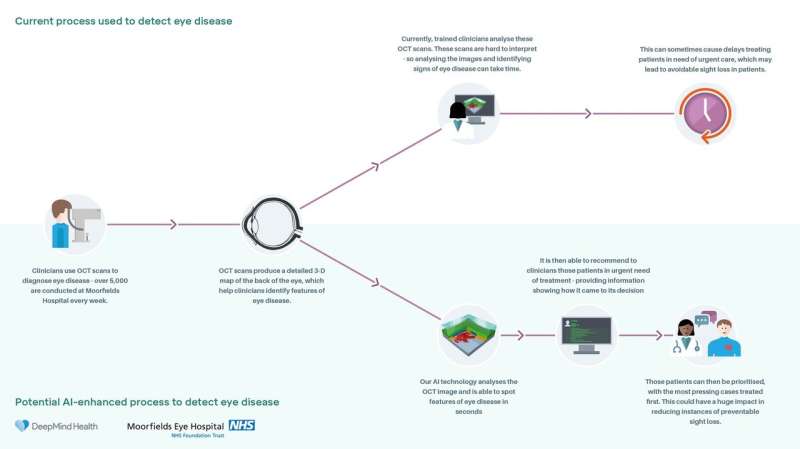Credit: DeepMind
Three institutions working together have applied DeepMind's neural network learning system to the task of discovering and diagnosing eye diseases. Moorfields Eye Hospital has been working with Google's DeepMind Health subsidiary and University College London in the effort, and have documented their progress in a paper published in Nature Medicine.
As the researchers note, eye doctors currently use a machine that carries out optical coherence tomography (OCT) on patients to find out if they have an eye disease. While the technique is quite useful and accurate, it requires highly trained doctors to spend time looking at results. The researchers suggest this creates a backlog that sometimes prevents patients from getting the care they need in time to save their vision. In this new effort, the researchers put together a system built on DeepMind's neural network learning system to find out if such a system could help doctors more quickly assess whether a patient needs urgent care.
The system the team put together consisted of two neural networks—the first analyzes the results of OCT scans and provides a map of possible problem areas. The second studies the map provided by the first neural network and then offers clinicians a diagnosis and recommendation regarding what needs to happen next for a given patient and when. Best of all, it can do its work in mere minutes, increasing the chances of recovery for at-risk patients. The system was trained by giving it 15,000 OCT scans from 7,500 patients and related diagnoses made by doctors. The researchers stress that the system is not meant to replace trained eye doctors, but to assist in more quickly identifying those who are most in need of urgent care. The team is hoping their system can move to clinical trials in the near future.
The study is but one of many geared toward applying the power of deep learning to health care. In another example, a team led by Eric Oermann used CT scans of 37,200 human heads to train a neural network to assist in the diagnosis of neurological ailments. The results of their efforts were published in the same issue of Nature Medicine.
More information: — DeepMind's blog: deepmind.com/blog/moorfields-major-milestone/
— Jeffrey De Fauw et al. Clinically applicable deep learning for diagnosis and referral in retinal disease, Nature Medicine (2018). DOI: 10.1038/s41591-018-0107-6
Abstract
The volume and complexity of diagnostic imaging is increasing at a pace faster than the availability of human expertise to interpret it. Artificial intelligence has shown great promise in classifying two-dimensional photographs of some common diseases and typically relies on databases of millions of annotated images. Until now, the challenge of reaching the performance of expert clinicians in a real-world clinical pathway with three-dimensional diagnostic scans has remained unsolved. Here, we apply a novel deep learning architecture to a clinically heterogeneous set of three-dimensional optical coherence tomography scans from patients referred to a major eye hospital. We demonstrate performance in making a referral recommendation that reaches or exceeds that of experts on a range of sight-threatening retinal diseases after training on only 14,884 scans. Moreover, we demonstrate that the tissue segmentations produced by our architecture act as a device-independent representation; referral accuracy is maintained when using tissue segmentations from a different type of device. Our work removes previous barriers to wider clinical use without prohibitive training data requirements across multiple pathologies in a real-world setting.
Journal information: Nature Medicine
© 2018 Medical Xpress
























